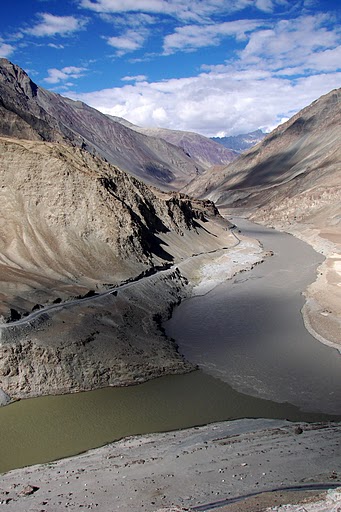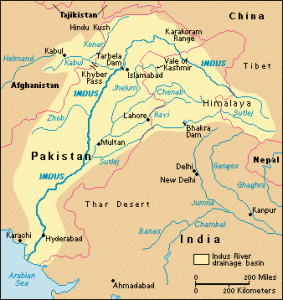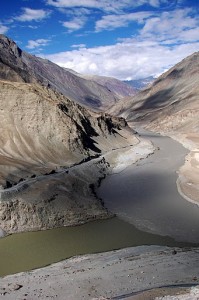
Water Sharing Between India and Pakistan: An Opportunity for Cooperation
Note from Andrew Holland: This is a guest post by Dhanasree Jayaram, a Ph.D. candidate in the Department of Geopolitics and International Relations at Manipal University, Karnataka, and an associate fellow at the Centre for Air Power Studies in New Delhi. This post gives an important view on how water resources in the Subcontinent could provide both opportunities for cooperation as well as challenges to conflict. You can see more of our work in this area in our ‘Perspectives’ article, “The Dams of the Himalayas” and these blog posts: here, here, and here (from my previous job).
The Letter of the Law
In February, the International Court of Arbitration issued a ruling partial award on the Kishanganga Dam dispute between India and Pakistan over the Indus River. This might succeed in bringing certain sense of closure to some of the differences that exist between India and Pakistan on the sharing of the waters of the Indus Basin – but the legal and political battles are far from over. The award will allow India to establish a hydro-electric dam on the Neelum, albeit under strict conditions that includes amendment to the design and operations of the dam.
 Several factors have complicated Indo-Pakistan water sharing relations in the past and will continue to do so in the future. Under the Indus Waters Treaty (IWT) brokered by the World Bank in 1960, India was granted exclusive rights over the waters of the Eastern Rivers – the Sutlej, the Beas and the Ravi – and their tributaries before the point where the rivers enter Pakistan, while Pakistan won the rights over the waters of the Western Rivers – the Indus, the Jhelum and the Chenab – and their tributaries. Pakistan’s share of the total Indus system is over 80 percent which makes India a beneficiary of less than 20 percent.
Several factors have complicated Indo-Pakistan water sharing relations in the past and will continue to do so in the future. Under the Indus Waters Treaty (IWT) brokered by the World Bank in 1960, India was granted exclusive rights over the waters of the Eastern Rivers – the Sutlej, the Beas and the Ravi – and their tributaries before the point where the rivers enter Pakistan, while Pakistan won the rights over the waters of the Western Rivers – the Indus, the Jhelum and the Chenab – and their tributaries. Pakistan’s share of the total Indus system is over 80 percent which makes India a beneficiary of less than 20 percent.
In the past decade, there have been many disputes over India and Pakistan’s shared waters: the construction of Baglihar Dam on the Chenab by the Indian side was obstructed by Pakistan. When Pakistan had moved the World Bank for arbitration, the latter appointed a neutral expert, Richard Laffite who gave green light to the project in 2007 thwarting the objections raised by the former about the structure and design of the dam.
Stresses to Current Laws
In Pakistan,there is increasing fear of water and food insecurity, a country that is entirely dependent on the waters of the Indus (and its tributaries). Pakistan fears that India has plans to construct 155 hydropower projects on the Indus, Jhelum (74) and Chenab (56), the three rivers that were assigned to Pakistan under the IWT. This number has however not been confirmed by the Indian authorities. Studies show clearly that the per capita availability of water is declining in both countries due to diminishing river flows, over-exploitation of groundwater (causing salinity), low conveyance efficiency and pollution of rivers.
Climate change is also exacerbating the situation and it could only worsen in the future as the Indus is one of those rivers that have maximum dependence (151 percent) on glacial meltwater. One study states, “Based on current projections, the Indus River system is expected to fall below 2000 flow levels between 2030 and 2050. The drop-off is estimated to be most serious between 2030 and 2040, with a new equilibrium flow of 20 percent below that of 2000 reached after 2060.”
On the politics side of the debate, Pervez Musharraf, former President of Pakistan claimed in his dissertation that the Kashmir dispute was primarily based on the distribution of the waters of the Indus and its tributaries between India and Pakistan. Stressing on the fair distribution of waters, he asserts, “If one were resolved, the other would not exist.” A few reports have also suggested that Pakistan would not hesitate to use its nuclear weapons against India if the latter chokes water supply to its territory.
 The present treaty has also been unpopular in India, and its Government has been under constant pressure to review it and even compensate local residents for the losses (mainly agricultural) incurred on account of the treaty. The legislative council of Jammu and Kashmir passed a resolution in 2002 exhorting the Government of India to review it “in the best interests of the people of the state.” The treaty has also been lambasted in India on the grounds that India signed it without an assessment of the future availability of water in the Indus system.
The present treaty has also been unpopular in India, and its Government has been under constant pressure to review it and even compensate local residents for the losses (mainly agricultural) incurred on account of the treaty. The legislative council of Jammu and Kashmir passed a resolution in 2002 exhorting the Government of India to review it “in the best interests of the people of the state.” The treaty has also been lambasted in India on the grounds that India signed it without an assessment of the future availability of water in the Indus system.
Recommendations: Towards Integrated Basin Management
The Indus (and its tributaries) is the lifeline of Pakistan and the effects of environmental change are being felt on both sides of the border. Instead of revising the treaty and wrestling over riparian politics, India and Pakistan could work towards integrated basin management as water security is emerging as a critical issue in both countries. Water management negotiations are the biggest confidence-building measure between the two countries.
At the same time, vituperative sentiments generated by certain sections of the Pakistani establishment need to be kept in check. Pakistan has time and again reiterated that the IWT is inequitable in nature and blamed India for water problems on Pakistan’s soil. The facts state otherwise. The Pakistan Army’s rhetoric against India that has always jeopardised the country’s relations with India (the upper riparian) in the past might have lowered but the militant networks operating in Pakistan are now adding fire to fuel. For example, Hafiz Sayeed, allegedly involved in the 2008 Mumbai terror attack openly accused India of ‘water terrorism’.
Finally, the Indus Water Treaty needs to be amended to take environmental change into consideration; the focus needs to shift to Article VII that is entitled “Future Cooperation” that emphasises setting up of new hydrological and meteorological observation stations and implementing engineering works including drainage ones. Moreover, groundwater extraction close to the border areas of both countries is overlooked by the IWT (focussing on surface water recharge), an area in which India and Pakistan could cooperate.
The IWT should not be treated as ‘division’ of waters as was the case during the Partition in 1947, when land was divided between the two countries. Water is an existential issue and both countries need to go beyond politics to cooperate on river water sharing.






China has made incursion 19 kms. inside India’s Ladakh region. The people of India and the Government of India are under great pressure. It is surprising that the media in the U.S.A. and the Government Of U.S.A.have not taken note of this event.India can not match the military power of China. India needs support of U.S. and other nations. President Obama has not made any statement. India is the most endangered nation in the world, facing mighty China all alone.